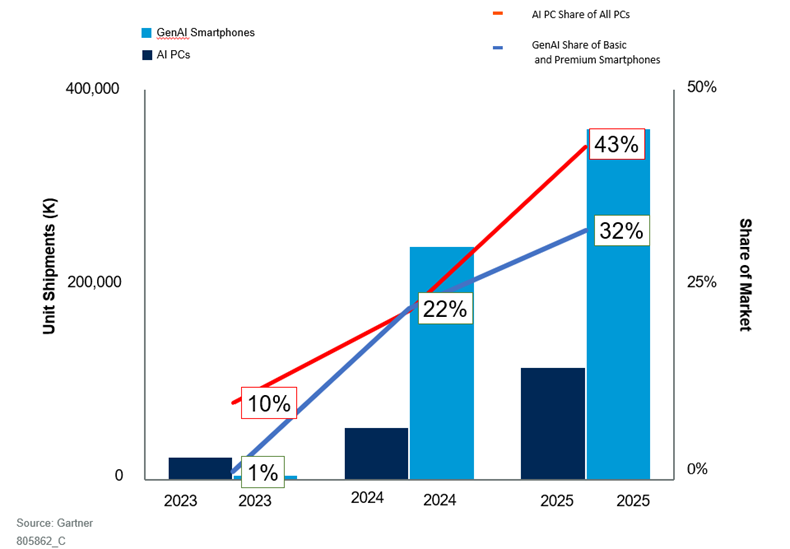
Gartner Predicts Worldwide Shipments of AI PCs and GenAI Smartphones to Total 295 Million Units in 2024
Worldwide shipments of AI PCs and generative AI (GenAI) smartphones are set to hit 295 million units in 2024, up from 29 million in 2023. Gartner predicts 240 million GenAI smartphones and 54.5 million AI PCs will be shipped by then.
February 15, 2024 — Worldwide shipments of AI PCs and generative AI (GenAI) smartphones are projected to total 295 million units by the end of 2024, up from 29 million units in 2023, according to a new forecast from Gartner, Inc.
Gartner defines AI PCs as PCs that are equipped with dedicated AI accelerators or cores, neural processing units (NPUs), accelerated processing units (APUs) or tensor processing units (TPUs), designed to optimize and accelerate AI tasks on the device. This provides improved performance and efficiency in handling AI and GenAI workloads without relying on external servers or cloud services.
GenAI smartphones are designed smartphones equipped with hardware and software capabilities that enable seamless integration and efficient execution of GenAI-driven features and applications on the smartphone. These smartphones are capable of locally running a base or fine-tuned AI model that generates new derived versions of content, strategies, designs and methods. Examples of this include Gemini Nano from Google, ERNIE from Baidu and OpenAI’s GPT-4.
“The rapid adoption of on-device GenAI capabilities and AI processors will eventually become a standard requirement for technology vendors,” said Ranjit Atwal, Senior Director Analyst at Gartner. “This ubiquity will pose challenges for vendors in differentiating themselves from competitors, making it harder to create unique selling points and drive increased revenues.”
Gartner estimates 240 million GenAI smartphones and 54.5 million AI PCs will be shipped by the end of 2024 (see Figure 1). This will represent 22% of basic and premium smartphones and 22% of all PCs in 2024.
Figure 1. AI PCs and GenAI Smartphones Market Share, Worldwide, 2023-2025

Source: Gartner (February 2024)
The integration of AI into PCs is not expected to drive end-user spending beyond anticipated price increases. Business device buyers will demand compelling reasons to invest. However, it will take time for software providers to harness the power of on-device AI and clearly demonstrate its enhanced benefits.
The PC market returned to growth in the fourth quarter of 2023 after eight consecutive quarters of decline. Gartner estimates overall PC shipments will total 250.4 million units in 2024, a 3.5% increase from 2023. On-device AI should rejuvenate the marketing of PCs through 2024 and help sustain existing anticipated replacement cycles, negating some of the negative effects of a disruptive socioeconomic environment.
Smartphone Market to Return to Growth in 2024
Like AI PCs, GenAI smartphones will not bolster smartphone demand until 2027. “The enhancements to smartphones evolve the current experiences with cameras and voice integration, but these capabilities are expected by users rather than demonstrating a new groundbreaking functionality. Users have the same expectation for the functionality of GenAI on their smartphone,” said Atwal. “They are unlikely to pay a premium for GenAI smartphones without the availability of any groundbreaking applications.”
The catalyst for transformative shifts in user experience lies in the advancement of smaller versions of large language models (LLMs) specifically tailored for smartphones. This evolution will transform smartphones into even more intuitive companions capable of comprehending and responding to human language and visual cues, which will elevate the overall user experience to new heights.
The smartphone market recorded its first quarter of growth in 4Q23 after nine consecutive quarters of decline. In 2024, worldwide smartphone shipments are expected to grow 4.2%, totalling 1.2 billion units year over year. “We should not interpret the growth in smartphone shipments as a full-fledged recovery,” said Atwal. “It is more accurate to view it as a stabilization of lower level of units, which are nearly 60 million lower than in 2022.”






